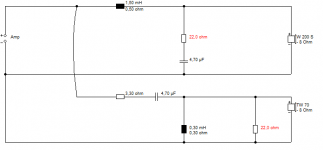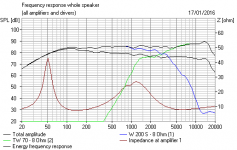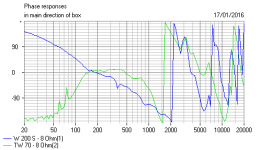If it doesn't it does not survive.
Great, so perhaps you can explain how speaker crossovers can violate basic conservation laws since Joe has declined to do so.
It is very unlikely that it does. But it is likely that there may that we are forgetting to account for.
Someone would need to carefully check the real object against a model.
Personally i don't care. How does it sound? If you have a current amp, it certainly has a good chance of sounding a lot better than the non-flat impedance XO.
dave
Someone would need to carefully check the real object against a model.
Personally i don't care. How does it sound? If you have a current amp, it certainly has a good chance of sounding a lot better than the non-flat impedance XO.
dave
information has a clear mathematical definition:
https://en.wikipedia.org/wiki/Information_theory
dave
I've lost count of the "discoveries" here that violate the very basics of IT.
While that is true, it is also true that we very often simplify a problem (assuming what we are tossing out is so small as to be irrelevant) to keep the math "easy", that it is possible for something to creap in that does affect things.
dave
Dave these are two statements, but I fail to se how they could be connected?
Jan
What Joe said was that KL might not be enuff on its own to figure out what is happening, i made a suggestion of where too look.
It was not Joe that said KL was violated, but others putting words in his mouth.
dave
It was not Joe that said KL was violated, but others putting words in his mouth.
dave
It was not Joe that said KL was violated
dave
Do you have another interpretation of "falls apart completely"? No one here would have even the least problem if Joe said maybe he exaggerated the issue a little, after all there is no need in the first place to bring in first principles to the speaker crossover issue.
Last edited:
Kirchoff's Law is violated in situations where there are induced currents or mechanical storage. Current flows without an emf. Hence this rocking motion might get overlooked by people who really don't think about what can happen in a speaker, here a parallel MTM:
system7
Kirchoff's Law isn’t violated in such cases (induced currents or mechanical storage).
Kirkoff’s law is retained, we only have to cater for induced currents and mechanical storage by adding the equivalent voltage sources in the circuit.
It is always about nodes, consumers and generators, the later intended (power amplifier) plus unintended (induced currents into some impedance, or mechanical storage giving back it’s energy in the form of back-EMF )
George
Joe's exact words have been quoted verbatim enough to exclude THAT!
Rather than requote them yet again, I merely note that the extraordinary claim has not been withdrawn, and despite massive walls of typing, has not been supported.
Like I said in the beginning, there's nothing wrong with flattening an impedance curve. It's been done by others as well and has the advantage of reducing amplifier criticality, along with some disadvantages (engineering is tradeoff). That's all we have here, nothing revolutionary or groundbreaking. And that's OK if we stop there and say, "Hey, this is a good sounding speaker design, and it won't matter much which amp you use, isn't that great?" The claims of violations of well-established physics are likely ridiculous, but all too common among merchants in the fashion audio business. That's the part I'm objecting to, and will continue to object to.
I've just edited my ignore list. Unfortunately there's one I can't get rid of. The worst one. 🙄
Because I want to talk about your Usher S-520 speaker, Joe. 🙂
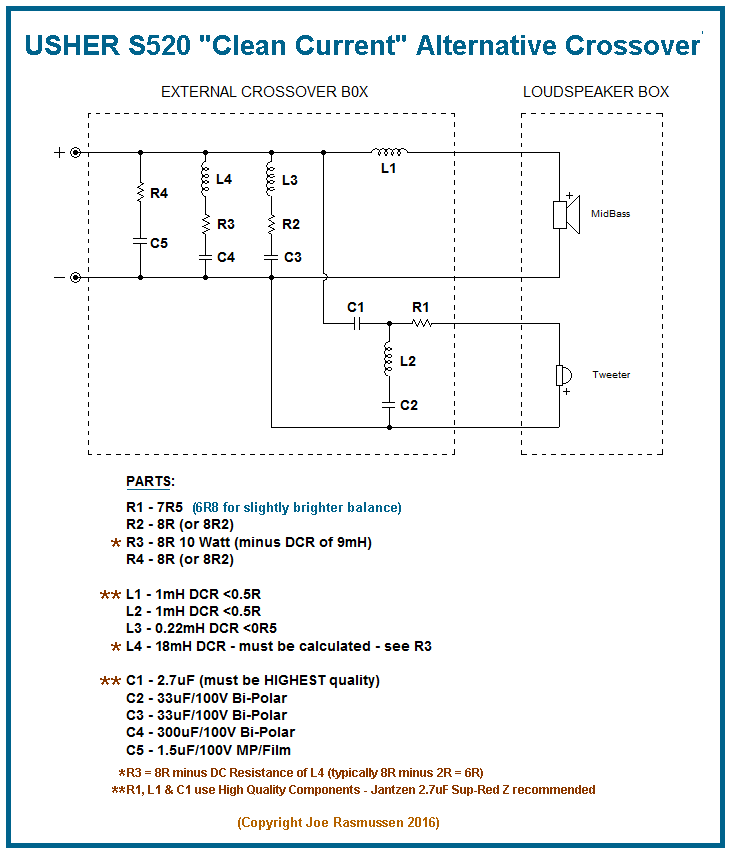
Impedance correction aside, is that the Usher designed "Core" filter, or your own? What did Usher fit?
Because I want to talk about your Usher S-520 speaker, Joe. 🙂

Impedance correction aside, is that the Usher designed "Core" filter, or your own? What did Usher fit?
I think I must have recommended www.firstwatt.com/pdf/art_cs_amps.pdf to a thousand people out there.
So you're the one.
😎
I have only had 4 1/2 hours of sleep and gotta work, so I will be brief. The last few posts mean that this thread is about to close down, at least discussion wise. The tone is now obvious. Very condescending.
The "nothing new here" line and that Croat now saying this is a marketing exercise (how it can be interpreted that way completely beyond me) means that will be the case. The 'usual suspects' have turned up.
Could you at least explain this:

So what is it you are asking me to explain? Why there is a bump in he SPL at 25 Hz when you drive the speaker with an amp with 270 ohms output Z as apposed to a smooth roll off when you drive it with an amp with negligible output Z?
It's all explained by your impedance figure

Since we are talking about low frequencies the series inductor with the woofer can be consider a short. Thus at low frequency the voltage across the woofer is approximately given as Vw/Vo = 1/(1 + Zo/Zs) where Vw is the voltage across the woofer, Vo is the source voltage, Zo is the source impedance and Zs is the speaker impedance from the plot (not to be confused with the woofer impedance, Zw). Now, you have not flattened Zs around 22 Hz. So when the Zo is much smaller than Zs, Vw = Vo independent of frequency. But when Zo = 270, above 22 Hz where Zs is about flat and approximately 6, Vw/Vo =0.021. But at the impedance peak Zs = 14 so Vw/Vo = 0.049. Or, more significantly, Vw at the impedance peak is 2.33 x Vw where the impedance is 6 ohms. Thus you expect a bump in the SPL of about peak 7.4 dB. From your SPL plot it looks to be about 8 which seems in reasonable agreement with this simple analysis. Put simply, it just a voltage divider effect of the 270 ohm source impedance with the speaker's Z.
As I said in my originals posts, with 270 ohms output Z this tends to make the system look like a constant current system because the current through the system is I = Vo /(270 + Zs) and there isn't much difference between 270 +6 and 270 + 14. But that doesn't mean that I through the VC is constant because the VC Z doesn't change and I through the VC is still Vw /Zw.
In sealed boxes it is often stated that a series resistor changes Qes and thus the damping of the system. In fact, nothing of the kind happens. The reality is just as I showed here. With a series resistance the voltage divider created by the series resistance and the woofer's Z result in a higher voltage being applied across the driver around the impedance peak leading to a boost in SPL which looks like a reduction in damping and be interpreted as such if you include the series resistance in defining the woofer's Dc R.
Anyway, I've spent way too much time on this. Sorry Joe but there is nothing here. It's all just twisting words around. In fact, as I showed in my look back impedance plots, with a low output Z amp your crossover has a very high peak in the look back Z which means that when driven by a low Z amp there could be significant ringing of the tweeter around 3k. That really depends on how much mechanical damping the tweeter has.
All the other nonsense about KL is just that and not worth addressing.
So I'm going to leave this thread at this point. Have fun. Don't take this stuff too seriously. It's basically a waste of time.
[edit]I just want to point out that if your amp is a true current source then there would be a slight increase in Vo at the impedance peak of the amount 284/276 = 1.028 > 0.24 dB which would account for another 0.24 dB rise in the SPL at the impedance peak. But the effect tis mostly the voltage divider.
Last edited:
Laws don't get violated at the non quantum level and no relativistic speed level here. Maybe what is meant is simply Kirchoff's law was used inppropriately and not all the terms were properly accounted for in the assumptions. Let's move on guys.
Laws don't get violated at the non quantum level and no relativistic speed level here. Maybe what is meant is simply Kirchoff's law was used inppropriately and not all the terms were properly accounted for in the assumptions. Let's move on guys.
Very well put.
Thank you.
Joe, I'm really feeling happy tonight. TBH, you are the only person at this wretched forum who has ever agreed with me that impedance matters. 😀
I've gotta admit I only throw images like this into the fray to assert my familiarity with quantum mechanics, because I am a College educated physicist and engineer, and irritate the dull and humourless gun-totin' trailer-trash here. Apparently Professor Albert Einstein never put socks on, and frequently forgot where he lived. Was he a retard? I DON'T THINK SO!

I think Quantum Mechanics does matter in speakers, as it goes, the very act of splitting the audio path between two drivers produces a measureable effect, or distortion, in the spatial acoustic field.
But we are really mainly interested in producing great speakers:
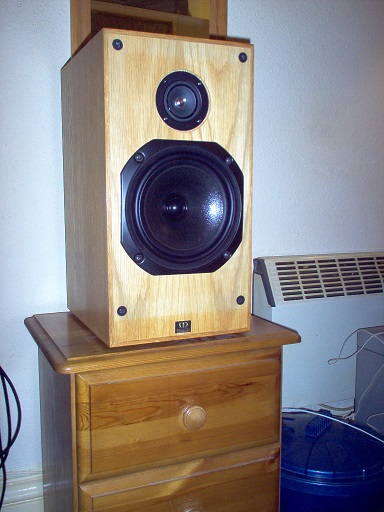
Here's my latest LR2 crossover which incorporates the "Rasmussen Resistor" effect. I built them this afternoon. They're cookin' on gas! They sound good. 😀
See, it doesn't matter whether you agree with EVERYTHING somebody says. Just that you take away the good parts. 😎
I've gotta admit I only throw images like this into the fray to assert my familiarity with quantum mechanics, because I am a College educated physicist and engineer, and irritate the dull and humourless gun-totin' trailer-trash here. Apparently Professor Albert Einstein never put socks on, and frequently forgot where he lived. Was he a retard? I DON'T THINK SO!

I think Quantum Mechanics does matter in speakers, as it goes, the very act of splitting the audio path between two drivers produces a measureable effect, or distortion, in the spatial acoustic field.
But we are really mainly interested in producing great speakers:

Here's my latest LR2 crossover which incorporates the "Rasmussen Resistor" effect. I built them this afternoon. They're cookin' on gas! They sound good. 😀
See, it doesn't matter whether you agree with EVERYTHING somebody says. Just that you take away the good parts. 😎
Attachments
 Thread closed for now. Much clean up done. Rants and damage mostly removed.
Thread closed for now. Much clean up done. Rants and damage mostly removed.Participants will stick to the topic, not make personal remarks, discuss religion, politics or forum moderation.
Failure to do so will result in penalties and possible loss of posting privileges.
Joe is in read only mode for the next 7 days.
EDIT: Thread open. Read and remember the warning above.
Joe,
When you come back to writing here (or in PM) I wonder if you could please post for me the T-S parameters of drivers. I don't own Usher520 but I still want to enjoy some analysis.
I could not write you PM for a reason that I cannot understand, maybe technical of some nature. Not QM for sure 🙂
If anybody can direct me to a dedicated X-over "noise" thread on DIY Forum, please PM. If not, I see here educational value to open one.
Thanks.
When you come back to writing here (or in PM) I wonder if you could please post for me the T-S parameters of drivers. I don't own Usher520 but I still want to enjoy some analysis.
I could not write you PM for a reason that I cannot understand, maybe technical of some nature. Not QM for sure 🙂
If anybody can direct me to a dedicated X-over "noise" thread on DIY Forum, please PM. If not, I see here educational value to open one.
Thanks.
Joe,
I read with interest the link you provided me from your post #71 about Esa Merilainen and "noise", between others ():😉
I read with interest the link you provided me from your post #71 about Esa Merilainen and "noise", between others ():😉
- Reflections returning from the cone rim.
- In a dome diaphragm, the returning of the mechanical wave back to the coil former joint
- Loose mass and reflection effects of the cone's inner suspension
- Modification of the effective mass due to waving and disconnection of the diaphragm.
- Bell modes developing in the cone at certain frequencies, causing the diaphragm to deform and divide into sectors that vibrate in different phases.
- Air currents through a perforated coil former and through the air gap of the magnetic circuit
- Stirring of ferrofluid around the voice coil
- Flexing of the voice coil adhesives and coil former. At the high end of the frequency range, cone travels are so tiny that even a slight compliance in the glue layers can introduce response alterations and even hysteresis.
- Air loading required for acoustic radiation. Especially on the part of backward radiation, this loading may include vague attributes.
Am I to understand that all this 'noise' is going to be fixed by changes in the crossover, as announced at the beginning of this thread? Or am I reading too much in your post?
Jan
Jan
- Status
- Not open for further replies.
- Home
- Loudspeakers
- Multi-Way
- Joe Rasmussen Usher S520 "Current Compatible" Crossover
